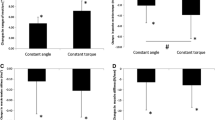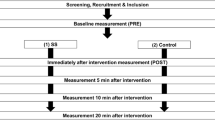Abstract
Purpose
Contract–relax (CR) stretching increases range of motion (ROM) substantively, however its use in athletic environments is limited as the contractions performed in a highly stretched position require partner assistance, are often painful, and may induce muscle damage. Therefore, the acute effects of performing the contractions ‘off stretch’ in the anatomical position [stretch–return–contract (SRC)] were compared with traditional CR stretching in 14 healthy human volunteers.
Methods
Passive ankle joint moment and dorsiflexion ROM were recorded on an isokinetic dynamometer with electromyographic monitoring of the triceps surae, whilst simultaneous real-time motion analysis and ultrasound imaging recorded gastrocnemius medialis muscle and Achilles tendon elongation. The subjects then performed CR or SRC stretches (4 × 10-s stretches and 5-s contractions) randomly on separate days before reassessment.
Results
Significant increases in dorsiflexion ROM (4.1°–4.0°; P < 0.01) and peak passive moment (10.9–15.1 %; P < 0.05) and decreases in the slope of the passive moment curve (19.1–13.3 %; P < 0.05), muscle stiffness (21.7–21.3 %; P < 0.01) and tendon stiffness (20.4–15.7 %; P < 0.01) were observed in CR and SRC, respectively. No between-condition differences were found in any measure (P > 0.05).
Conclusions
Similar mechanical and neurological changes were observed between conditions, indicating that identical mechanisms underpin the ROM improvements. These data have important practical implications for the use of this stretching mode in athletic environments as performing the contractions ‘off stretch’ eliminates the pain response, reduces the risk of inducing muscle damage, and removes the need for partner assistance. Thus, it represents an equally effective, simpler, and yet potentially safer, stretching paradigm.






Similar content being viewed by others
Abbreviations
- CI:
-
Confidence intervals
- CR:
-
Contract–relax
- EMG:
-
Electromyography
- GL:
-
Gastrocnemius lateralis
- GM:
-
Gastrocnemius medialis
- ICC:
-
Intraclass correlation coefficient
- MTC:
-
Muscle–tendon complex
- MTJ:
-
Muscle–tendon junction
- MVC:
-
Maximal voluntary contraction
- PNF:
-
Proprioceptive neuromuscular facilitation
- ROM:
-
Range of motion
- Sol:
-
Soleus
- SE:
-
Standard error
- SRC:
-
Stretch–return–contract
- TA:
-
Tibialis anterior
- TTL:
-
Transistor–transistor logic
References
Avela J, Kyröläinen H, Komi PV (1999) Altered reflex sensitivity due to repeated and prolonged passive muscle stretching. J Appl Physiol 86:1283–1291
Avela J, Finni T, Liikavainio T, Niemela E, Komi PV (2004) Neural and mechanical responses of the triceps surae muscle group after 1 h of repeated fast passive stretches. J Appl Physiol 96:2325–2332. doi:10.1152/japplphysiol.01010.2003
Balnave CD, Davey DF, Allen DG (1997) Distribution of sarcomere length and intracellular calcium in mouse skeletal muscle following stretch-induced injury. J Physiol 502:649–659. doi:10.1111/j.1469-7793.1997.649bj.x
Bassey EJ, Morgan K, Dallosso HM, Ebrahim SB (1989) Flexibility of the shoulder joint measured as range of abduction in a large representative sample of men and women over 65 years of age. Eur J Appl Physiol Occup 58:353–360. doi:10.1007/BF00643509
Beaulieu JE (1981) Developing a stretching program. Phys Sportsmed 9:59–69
Blazevich AJ, Cannavan D, Waugh C, Fath F, Miller S, Kay AD (2012) Neuromuscular factors influencing the maximum stretch limit of the human plantar flexors. J Appl Physiol 113:1446–1455. doi:10.1152/japplphysiol.00882.2012
Blazevich AJ, Cannavan D, Waugh C et al (2014) Range of motion, neuromechanical and architectural adaptations to plantar flexor stretch training in humans. J Appl Physiol 17:452–462. doi:10.1152/japplphysiol.00204.2014
Butterfield TA, Herzog W (2006) Effect of altering starting length and activation timing of muscle on fiber strain and muscle damage. J Appl Physiol 100:1489–1498. doi:10.1152/japplphysiol.00524.2005
Cresswell AG, Loscher WN, Thorstensson A (1995) Influence of gastrocnemius muscle length on triceps surae torque development and electromyographic activity in man. Exp Brain Res 105:283–290. doi:10.1007/BF00240964
Duffin AC, Donaghue KC, Potter M et al (1999) Limited joint mobility in the hands and feet of adolescents with type 1 diabetes mellitus. Diabet Med 16:125–130. doi:10.1046/j.1464-5491.1999.00030.x
Funk DC, Swank AM, Mikla BM, Fagan TA, Farr BK (2003) Impact of prior exercise on hamstring flexibility: a comparison of proprioceptive neuromuscular facilitation and static stretching. J Strength Cond Res 17:489–492
Herda TJ, Costa PB, Walter AA, Ryan ED, Cramer JT (2014) The time course of the effects of constant-angle and constant-torque stretching on the muscle–tendon unit. Scand J Med Sci Sports 24:62–67. doi:10.1111/j.1600-0838.2012.01492.x
Hindle KB, Whitcomb TJ, Briggs WO, Hong J (2012) Proprioceptive neuromuscular facilitation (PNF): its mechanisms and effects on range of motion and muscular function. J Hum Kinet 31:105–113. doi:10.2478/v10078-012-0011-y
Karamanidis K, Stafilidis S, DeMonte G, Morey-Klapsing G, Bruggemann G, Arampatzis A (2005) Inevitable joint angular rotation affects muscle architecture during isometric contraction. J Electromyogr Kines 15:608–616. doi:10.1016/j.jelekin.2005.02.001
Kawakami Y, Ichinose Y, Fukunaga T (1998) Architectural and functional features of human triceps surae muscles during contraction. J Appl Physiol 85:398–404
Kay AD, Blazevich AJ (2008) Reductions in active plantarflexor moment are significantly correlated with static stretch duration. Eur J Sport Sci 8:41–46. doi:10.1080/17461390701855505
Kay AD, Blazevich AJ (2009a) Moderate-duration static stretch reduces active and passive plantar flexor moment but not Achilles tendon stiffness or active muscle length. J Appl Physiol 106:1249–1256. doi:10.1152/japplphysiol.91476.2008
Kay AD, Blazevich AJ (2009b) Isometric contractions reduce plantar flexor moment, Achilles tendon stiffness and neuromuscular activity but remove the subsequent effects of stretch. J Appl Physiol 107:1181–1189. doi:10.1152/japplphysiol.00281.2009
Kay AD, Husbands-Beasley J, Blazevich AJ (2015) Effects of contract–relax, static stretching, and isometric contractions on muscle–tendon mechanics. Med Sci Sport Exer 47:2181–2190. doi:10.1249/MSS.0000000000000632
Kubo K, Kanehisa H, Ito M, Fukunaga T (2001) Effects of isometric training on the elasticity of human tendon structures in vivo. J Appl Physiol 91:26–32
Kubo K, Kanehisa H, Fukunaga T (2002) Effects of transient muscle contractions and stretching on the tendon structures in vivo. Acta Physiol Scand 175:157–164. doi:10.1046/j.1365-201X.2002.00976.x
Macpherson PCD, Dennis RG, Faulkner JA (1997) Sarcomere dynamics and contraction-induced injury to maximally activated single muscle fibres from soleus muscles of rats. J Physiol 500:523–533. doi:10.1113/jphysiol.1997.sp022038
Maganaris CN (2001) Force–length characteristics of in vivo human skeletal muscle. Acta Physiol Scand 172:279–285. doi:10.1046/j.1365-201x.2001.00799.x
Maganaris CN (2003) Force–length characteristics of the in vivo human gastrocnemius muscle. Clin Anat 16:215–223. doi:10.1002/ca.10064
Magnusson SP, Simonsen EB, Aagaard P, Sorensen H, Kjaer M (1996) A mechanism for altered flexibility in human skeletal muscle. J Physiol 497:291–298. doi:10.1113/jphysiol.1996.sp021768
Manal K, Cowder JD, Buchanan TS (2013) Subject-specific measures of Achilles tendon moment arm using ultrasound and video-based motion capture. Physiol Rep 1:e00139. doi:10.1002/phy2.139
Mazzullo JM (1978) The gate theory of pain. Br Med J 2:586–587
McNair PJ, Dombroski EW, Hewson DJ, Stanley SN (2001) Stretching at the ankle joint: viscoelastic responses to holds and continuous passive motion. Med Sci Sport Exer 33:354–358
Melzack R (1993) Pain: past, present and future. Can J Exp Psychol 47:615–629
Mitchell UH, Myrer JW, Hopkins JT, Hunter I, Feland JB, Hilton SC (2007) Acute stretch perception alteration contributes to the success of the PNF “contract-relax” stretch. J Sport Rehabil 16:85–88
Mitchell UH, Myrer JW, Hopkins JT, Hunter I, Feland JB, Hilton SC (2009) Neurophysiological reflex mechanisms’ lack of contribution to the success of PNF stretches. J Sport Rehabil 18:343–357
Morse CI, Degens H, Seynnes OR, Maganaris CN, Jones AJ (2008) The acute effect of stretching on the passive stiffness of the human gastrocnemius muscle tendon unit. J Physiol 586:97–106. doi:10.1113/jphysiol.2007.140434
Mulholland SJ, Wyss UP (2001) Activities of daily living in non-Western cultures: range of motion requirements for hip and knee joint implants. Int J Rehabil Res 24:191–198
Murray MP, Guten GN, Baldwin JM, Gardener GM (1976) A comparison of plantar flexion torque with and without the triceps surae. Acta Orthop Scand 47:122–124. doi:10.3109/17453677608998984
Osternig LR, Robertson RN, Troxel RK, Hansen P (1990) Differential responses to proprioceptive neuromuscular facilitation (PNF) stretch techniques. Med Sci Sport Exer 22:106–111
Prentice W (1983) A comparison of static stretching and PNF stretching for improving hip joint flexibility. J Athl Train 18:56–59
Proske U, Morgan DL (1999) Do cross-bridges contribute to the tension during stretch of passive muscle? J Muscle Res Cell M 20:433–442. doi:10.1023/A:1005573625675
Sharman MJ, Cresswell AG, Riek S (2006) Proprioceptive neuromuscular facilitation stretching: mechanisms and clinical implications. Sports Med 36:929–939. doi:10.2165/00007256-200636110-00002
Waugh CM, Blazevich AJ, Fath F, Korff T (2012) Age-related changes in mechanical properties of the Achilles tendon. J Anat 220:144–155. doi:10.1111/j.1469-7580.2011.01461.x
Weppler CH, Magnusson SP (2010) Increasing muscle extensibility: a matter of increasing length or modifying sensation? Phys Ther 90:438–449. doi:10.2522/ptj.20090012
Whitehead NP, Morgan DL, Gregory JE, Proske U (2003) Rises in whole muscle passive tension of mammalian muscle after eccentric contractions at different lengths. J Appl Physiol 95:1224–1234. doi:10.1152/japplphysiol.00163.2003
Witvrouw E, Danneels L, Asselman P, D’Have T, Cambier D (2003) Muscle flexibility as a risk factor for developing muscle injuries in male professional soccer players. A prospective study. Am J Sports Med 31:41–46
Acknowledgments
No funding was received for this work.
Author information
Authors and Affiliations
Corresponding author
Ethics declarations
Conflict of interest
The authors declare that they have no conflict of interest.
Additional information
Communicated by Olivier Seynnes.
Rights and permissions
About this article
Cite this article
Kay, A.D., Dods, S. & Blazevich, A.J. Acute effects of contract–relax (CR) stretch versus a modified CR technique. Eur J Appl Physiol 116, 611–621 (2016). https://doi.org/10.1007/s00421-015-3320-8
Received:
Accepted:
Published:
Issue Date:
DOI: https://doi.org/10.1007/s00421-015-3320-8




